Archaeological investigations associated with the installation of the security bollards around the perimeter of the Plaza has been continuing along. Five areas have been opened up, with only one significant feature encountered to date. The feature consists of a compacted surface in the vicinity of the south gate of the mission compound. Archaeologists from UTSA- Center for Archaeological Research are working with the City, Texas Historical Commission, and Texas General Land Office to develop a plan to not impact the feature with the bollard installation. All other areas have been encountering road base material under the concrete surface to the depth of impact.
Archaeology Update — Excavations Outside The Long Barrack Begin
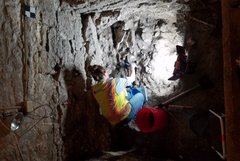
The archaeological investigations conducted by Raba Kistner, Inc. have continued in and around the Long Barrack. Three units are being excavated within the structure. Two have been opened on the exterior or the Long Barrack. All three units inside the structure are exhibiting a builder’s trench adjacent to the walls. In addition, the builder’s trench cuts into compacted surfaces likely representing floors. Since the builder’s trench cuts into the compacted surface, this indicates that the trench was dug at a later date than the compacted surfaces were created. When reviewing the historic use of the Long Barrack, the builder’s trenches could potentially pertain to more recent (between 1913 and 1968) work conducted on the building.
Excavations within the Long Barrack in the southern-most unit, have extended to a depth of approximately 1.7 meters below surface. The amount of artifacts has decreased at this depth, and seem to consist of mainly very early mission period occupation items (i.e. Native American pottery called Goliad Ware). Archaeologists are hoping this means they are nearing the base of the foundation. An increased amount of limestone cobbles also may indicate that have neared the transition between soils that contain artifacts, and the layer of soil that is older than human occupation. Recently drilling for water monitoring wells behind the Church revealed that that transition may be as close as 5 feet below the current surface. The cores of soil removed as the three 4-inch diameter wells were excavated showed that transition varied between 5 and 7.5 feet below the surface.
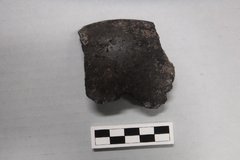
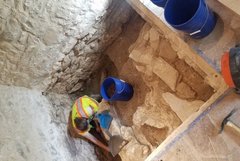
Early in the week, preparations were made to start a partner unit on the exterior of the north wall of the Long Barrack. By mid-week, archaeologists were able to begin excavations. The first level of excavations revealed road base, wood bits, and bits of shiny black material. Archival information notes that the Plaza was once paved with wood blocks. Later, the road in front of the Alamo Church was paved with asphalt. It is possible that the archaeologists are encountering bits of the wooden paver blocks and remnants of the asphalt tar.
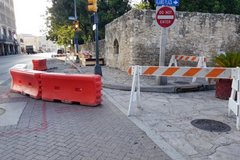
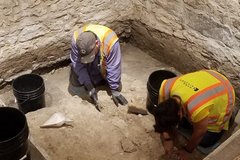
At the end of last week, a new unit had been opened on the interior of the Long Barrack, approximately mid-way between the north and south ends, along the west wall. Compacted caliche surfaces were noted in the eastern portion of the unit, with evidence of a builder’s trench along the walls. During the week, stone masons removed the flag stone and cut concrete to prepare for a partner unit on the exterior of the structure. The partner unit was opened on the exterior of the Long Barrack by Friday.
Excavations will continue focused on the Long Barrack into next week. Although the sidewalk alongside the western wall of the Long Barrack is closed, the rest of the Plaza is accessible to the public.

